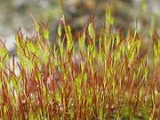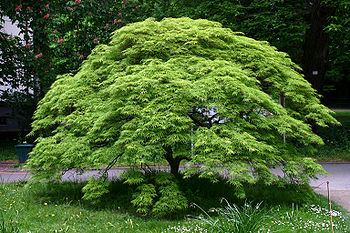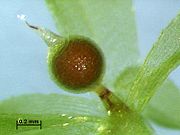
Sporophyte
Encyclopedia

Algae
Algae are a large and diverse group of simple, typically autotrophic organisms, ranging from unicellular to multicellular forms, such as the giant kelps that grow to 65 meters in length. They are photosynthetic like plants, and "simple" because their tissues are not organized into the many...
, have life cycles in which a haploid gametophyte
Gametophyte
A gametophyte is the haploid, multicellular phase of plants and algae that undergo alternation of generations, with each of its cells containing only a single set of chromosomes....
generation alternates with a diploid sporophyte, the generation of a plant
Plant
Plants are living organisms belonging to the kingdom Plantae. Precise definitions of the kingdom vary, but as the term is used here, plants include familiar organisms such as trees, flowers, herbs, bushes, grasses, vines, ferns, mosses, and green algae. The group is also called green plants or...
or algae that has a double set of chromosome
Chromosome
A chromosome is an organized structure of DNA and protein found in cells. It is a single piece of coiled DNA containing many genes, regulatory elements and other nucleotide sequences. Chromosomes also contain DNA-bound proteins, which serve to package the DNA and control its functions.Chromosomes...
s. A multicellular sporophyte generation or phase is present in the life cycle of all land plants and in some green algae
Charales
Charales is an order of pondweeds, freshwater algae in the division Charophyta. They are green plants believed to be the closest relatives of the green land plants. Linnaeus established the genus Chara in 1753.-Description:...
. For common flowering plant
Flowering plant
The flowering plants , also known as Angiospermae or Magnoliophyta, are the most diverse group of land plants. Angiosperms are seed-producing plants like the gymnosperms and can be distinguished from the gymnosperms by a series of synapomorphies...
s (Angiosperms), the sporophyte generation makes up almost their whole life cycle (i.e. whole green plant, roots etc.), except phases of small reproductive structures (pollen
Pollen
Pollen is a fine to coarse powder containing the microgametophytes of seed plants, which produce the male gametes . Pollen grains have a hard coat that protects the sperm cells during the process of their movement from the stamens to the pistil of flowering plants or from the male cone to the...
and ovule
Ovule
Ovule means "small egg". In seed plants, the ovule is the structure that gives rise to and contains the female reproductive cells. It consists of three parts: The integument forming its outer layer, the nucellus , and the megaspore-derived female gametophyte in its center...
).
The sporophyte produces spore
Spore
In biology, a spore is a reproductive structure that is adapted for dispersal and surviving for extended periods of time in unfavorable conditions. Spores form part of the life cycles of many bacteria, plants, algae, fungi and some protozoa. According to scientist Dr...
s (hence the name), by meiosis
Meiosis
Meiosis is a special type of cell division necessary for sexual reproduction. The cells produced by meiosis are gametes or spores. The animals' gametes are called sperm and egg cells....
. These meiospores develop into a gametophyte
Gametophyte
A gametophyte is the haploid, multicellular phase of plants and algae that undergo alternation of generations, with each of its cells containing only a single set of chromosomes....
. Both the spores and the resulting gametophyte are haploid, meaning they only have one set of homologous chromosome
Homologous chromosome
Homologous chromosomes are chromosome pairs of approximately the same length, centromere position, and staining pattern, with genes for the same characteristics at corresponding loci. One homologous chromosome is inherited from the organism's mother; the other from the organism's father...
s. The mature gametophyte produces male or female gamete
Gamete
A gamete is a cell that fuses with another cell during fertilization in organisms that reproduce sexually...
s (or both) by mitosis
Mitosis
Mitosis is the process by which a eukaryotic cell separates the chromosomes in its cell nucleus into two identical sets, in two separate nuclei. It is generally followed immediately by cytokinesis, which divides the nuclei, cytoplasm, organelles and cell membrane into two cells containing roughly...
. The fusion of male and female gametes produces a diploid zygote
Zygote
A zygote , or zygocyte, is the initial cell formed when two gamete cells are joined by means of sexual reproduction. In multicellular organisms, it is the earliest developmental stage of the embryo...
which develops into a new sporophyte. This cycle is known as alternation of generations
Alternation of generations
Alternation of generations is a term primarily used in describing the life cycle of plants . A multicellular sporophyte, which is diploid with 2N paired chromosomes , alternates with a multicellular gametophyte, which is haploid with N unpaired chromosomes...
or alternation of phases.

Chromosome
A chromosome is an organized structure of DNA and protein found in cells. It is a single piece of coiled DNA containing many genes, regulatory elements and other nucleotide sequences. Chromosomes also contain DNA-bound proteins, which serve to package the DNA and control its functions.Chromosomes...
s into two halves causes complications.
Bryophytes (moss
Moss
Mosses are small, soft plants that are typically 1–10 cm tall, though some species are much larger. They commonly grow close together in clumps or mats in damp or shady locations. They do not have flowers or seeds, and their simple leaves cover the thin wiry stems...
es, liverwort
Marchantiophyta
The Marchantiophyta are a division of bryophyte plants commonly referred to as hepatics or liverworts. Like other bryophytes, they have a gametophyte-dominant life cycle, in which cells of the plant carry only a single set of genetic information....
s and hornworts) have a dominant gametophyte stage on which the adult sporophyte is dependent on the gametophyte for nutrition. The embryo
Embryo
An embryo is a multicellular diploid eukaryote in its earliest stage of development, from the time of first cell division until birth, hatching, or germination...
of the sporophyte develops from the zygote within the female sex organ or archegonium
Archegonium
An archegonium , from the ancient Greek ἀρχή and γόνος , is a multicellular structure or organ of the gametophyte phase of certain plants, producing and containing the ovum or female gamete. The archegonium has a long neck canal and a swollen base...
, and in its early development is therefore nurtured by the gametophyte.
Because this embryo-nurturing feature of the life cycle is common to all land plants they are known collectively as the Embryophytes.

Algae
Algae are a large and diverse group of simple, typically autotrophic organisms, ranging from unicellular to multicellular forms, such as the giant kelps that grow to 65 meters in length. They are photosynthetic like plants, and "simple" because their tissues are not organized into the many...
have dominant gametophyte generations, but in some species the gametophytes and sporophytes are morphologically similar (isomorphic). An independent sporophyte is the dominant form in all clubmosses, horsetail
Horsetail
Equisetum is the only living genus in the Equisetaceae, a family of vascular plants that reproduce by spores rather than seeds.Equisetum is a "living fossil", as it is the only living genus of the entire class Equisetopsida, which for over one hundred million years was much more diverse and...
s, fern
Fern
A fern is any one of a group of about 12,000 species of plants belonging to the botanical group known as Pteridophyta. Unlike mosses, they have xylem and phloem . They have stems, leaves, and roots like other vascular plants...
s, gymnosperm
Gymnosperm
The gymnosperms are a group of seed-bearing plants that includes conifers, cycads, Ginkgo, and Gnetales. The term "gymnosperm" comes from the Greek word gymnospermos , meaning "naked seeds", after the unenclosed condition of their seeds...
s, and angiosperms (flowering plants) that have survived to the present day. Early land plants had sporophytes that produced identical spores (isosporous or homosporous) but the ancestors of the gymnosperms evolved complex heterosporous life cycles in which the spores producing male and female gametophytes were of different sizes, the female megaspore
Megaspore
Megaspores, also called macrospores, are a type of spore that is present in heterosporous plants. These types of plants have two spore types, megaspores and microspores. Generally speaking, the megaspore, or large spore, germinates into a female gametophyte, which is fertilized by sperm produced...
s tending to be larger, and fewer in number, than the male microspore
Microspore
In biology, a microspore is a small spore as contrasted to the larger megaspore.In botany, microspores develop into male gametophytes, whereas megaspores develop into female gametophytes. The combination of megaspores and microspores is found only in heterosporous organisms...
s.
During the Devonian
Devonian
The Devonian is a geologic period and system of the Paleozoic Era spanning from the end of the Silurian Period, about 416.0 ± 2.8 Mya , to the beginning of the Carboniferous Period, about 359.2 ± 2.5 Mya...
period several plant groups independently evolved heterospory
Heterospory
Heterospory is the production of spores of two different sizes and sexes by the sporophytes of land plants. Heterospory was evolved from isospory independently by several plant groups in the Devonian period as part of the process of evolution of the timing of sex differentiation...
and subsequently the habit of endospory, in which single megaspores were retained within the sporangia of the parent sporophyte, instead of being freely liberated into the environment as in ancestral exosporous plants. These endosporic megaspores contained within them a miniature multicellular female gametophyte complete with female sex organs or archegonia containing oocytes which were fertilised by free-swimming sperm
Sperm
The term sperm is derived from the Greek word sperma and refers to the male reproductive cells. In the types of sexual reproduction known as anisogamy and oogamy, there is a marked difference in the size of the gametes with the smaller one being termed the "male" or sperm cell...
produced by windborne miniatuarised male gametophytes in the form of pre-pollen
Pollen
Pollen is a fine to coarse powder containing the microgametophytes of seed plants, which produce the male gametes . Pollen grains have a hard coat that protects the sperm cells during the process of their movement from the stamens to the pistil of flowering plants or from the male cone to the...
. The resulting zygote
Zygote
A zygote , or zygocyte, is the initial cell formed when two gamete cells are joined by means of sexual reproduction. In multicellular organisms, it is the earliest developmental stage of the embryo...
developed into the next sporophyte generation while still retained within the pre-ovule
Ovule
Ovule means "small egg". In seed plants, the ovule is the structure that gives rise to and contains the female reproductive cells. It consists of three parts: The integument forming its outer layer, the nucellus , and the megaspore-derived female gametophyte in its center...
, the single large female meiospore or megaspore
Megaspore
Megaspores, also called macrospores, are a type of spore that is present in heterosporous plants. These types of plants have two spore types, megaspores and microspores. Generally speaking, the megaspore, or large spore, germinates into a female gametophyte, which is fertilized by sperm produced...
contained in the modified sporangium
Sporangium
A sporangium is an enclosure in which spores are formed. It can be composed of a single cell or can be multicellular. All plants, fungi, and many other lineages form sporangia at some point in their life cycle...
or nucellus of the parent sporophyte. The evolution of heterospory and endospory were among the earliest steps in the evolution of seed
Seed
A seed is a small embryonic plant enclosed in a covering called the seed coat, usually with some stored food. It is the product of the ripened ovule of gymnosperm and angiosperm plants which occurs after fertilization and some growth within the mother plant...
s of the kind produced by gymnosperm
Gymnosperm
The gymnosperms are a group of seed-bearing plants that includes conifers, cycads, Ginkgo, and Gnetales. The term "gymnosperm" comes from the Greek word gymnospermos , meaning "naked seeds", after the unenclosed condition of their seeds...
s and angiosperms today.

